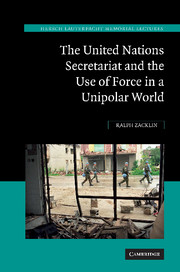1 - The Iraq–Kuwait conflict
Published online by Cambridge University Press: 07 September 2011
Summary
The Security Council's actions in response to Iraq's invasion of Kuwait in 1990 were in many respects the model of what collective security under the Charter could be in a kind of post-modern interpretation of Chapter VII enforcement. After decades of Cold War paralysis the Security Council appeared to have been revitalized. Charter provisions which had previously been held in abeyance or only sparingly utilized were being implemented. The Security Council took centre stage and the establishment of a new world order, however improbable, appeared possible. No one serving in the Secretariat at that time had ever seen anything like it.
The euphoria did not last long. Within a short time, serious differences began to emerge between the Secretariat and the main coalition partners concerning both the process and the content of the Security Council's actions. By the end of the 100 hours ground phase of the combat in February 1991 the Secretary-General had begun to raise questions about the compatibility of certain tactics with the laws of war and humanitarian law. What had started out as an enforcement action under Chapter VII with the imprimatur of the United Nations had evolved into a military engagement by third parties over which the Security Council exercised little or no control. Within days of the end of combat operations the Secretary-General publicly distanced the United Nations from Desert Storm.
- Type
- Chapter
- Information
- The United Nations Secretariat and the Use of Force in a Unipolar WorldPower v. Principle, pp. 7 - 44Publisher: Cambridge University PressPrint publication year: 2010

